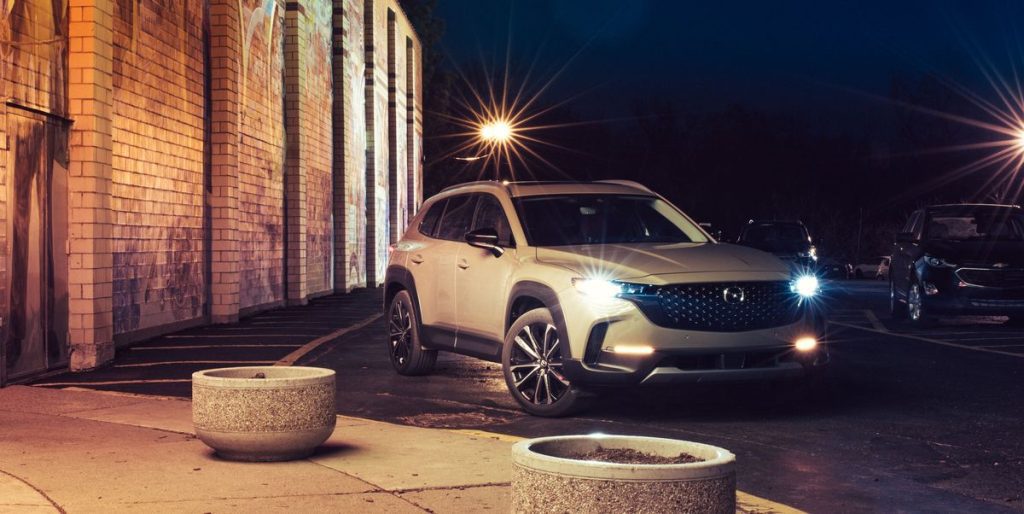Tested: 2023 Mazda CX-50 2.5 Turbo Builds on the CX-5's Base

UPDATE 6/2/22: This review has been updated with test results.
From the June 2022 issue of Car and Driver.
Mazda has never been short on original ideas. This is the company that is still trying to make the Wankel engine work and that stubbornly insists on selling a tiny two-seat roadster even as most other affordable sports cars have gone the way of Triumph, MG, or, well, pretty much the British car industry. So maybe that’s why it seems unoriginal for Mazda to chase the exact same outdoorsy, rugged image that Jeep, Subaru, and many others have done to death.
Marketing images of the new 2023 CX-50 show the SUV plowing through the forest festooned with all manner of off-road and camping accessories. For this model Mazda even came up with a new exterior color called Zircon Sand, which is meant to make adventuresome shoppers think they can conquer the dunes—or at least imagine doing so.
Roy RitchieCar and Driver
If we were to hazard a guess, we’d say Mazda is doing all of this to differentiate the CX-50 from its other compact SUV, the CX-5. The company asserts that there’s enough room in this popular segment for two similarly sized vehicles, and Mazda won’t be the first to double up: Jeep sells the Cherokee and the Compass, and Ford has both the Escape and the Bronco Sport.
HIGHS: Refined powertrain, good ride and handling balance, premium looks.
We decided to ignore the outdoorsy shtick and instead found the CX-50 to have a pleasant on-road driving demeanor, an appealing design, and class-above refinement—all for about the same price as its mainstream competitors. If that sounds like a familiar refrain, it’s because we’ve heaped similar praise upon the CX-5, which has won multiple 10Best awards and is Mazda’s bestseller by far.
The CX-50 and CX-5 share powertrains, but there are notable differences in the packaging. The CX-50’s body is 1.4 inches lower, 3.0 inches wider, and 5.7 inches longer (most of that length is from a 4.6-inch wheelbase stretch), giving it station-wagon-esque proportions that are more Subaru Outback than Forester. Although the CX-50’s black plastic cladding and faux vents are a bit overdone, we like its more athletic stance and wide haunches. It all comes together in a design that’s far more modern than that of the current CX-5, which got a facelift for 2022 but still doesn’t look all that different than it did in 2017.
The optional Terracotta leather interior with contrasting stitching is more luxe than what you find in some premium brands.
Roy RitchieCar and Driver
Compared with its stablemate, the CX-50 does offer a bit of real capability to go with the imagined variety. For one, it has slightly more ground clearance than the CX-5. And Mazda says it beefed up the CX-50’s engine cooling to increase towing capacity: Equipped with the optional turbo engine, the CX-50 can tow up to 3500 pounds, while the CX-5 Turbo maxes out at 2000. Towing and Off-Road drive modes join the Normal and Sport selections and bring different calibrations for the steering, transmission, all-wheel-drive system, and throttle response. An upcoming off-road-themed CX-50 Meridian Edition will offer all-terrain tires, along with a hood graphic, a basket rack, and a few other accessories.
Given that its turbocharged 2.5-liter inline-four—which makes 256 horsepower on 93-octane fuel and 227 horsepower on 87-octane—and six-speed automatic transmission are shared with upper trims of the CX-5, much of the driving experience is familiar. (We assume the same will apply to the CX-50’s base powertrain, a 187-hp naturally aspirated 2.5-liter inline-four.) The turbo engine provides a strong swell of low-end torque, and the transmission shifts crisply and does a great job of predicting what gear you want.
Roy RitchieCar and Driver
LOWS: Infotainment quirks, costlier than a CX-5, trying too hard for a rugged image.
Unlike with most mainstream vehicles, engaging the CX-50’s Sport mode actually does something: The steering firms up and the throttle mapping is noticeably snappier, so much so that it improves the CX-50’s acceleration by a few tenths. Saddled with an extra 57 pounds compared with the last CX-5 Signature we tested, our all-wheel-drive CX-50 2.5 Turbo test car got to 60 mph in 6.6 seconds and through the quarter-mile in 15.1 seconds at 91 mph. Those numbers are a few ticks behind the CX-5’s but are still strong for the segment. Most SUVs in this class don’t offer upgrade engines at all—only the Bronco Sport and Escape with their optional turbo 2.0-liter four deliver similar acceleration.
With predictable handling and sports-car-accurate steering, the CX-50 is a pleasure to hustle through corners. It delivered an impressive 0.87 g on the skidpad and stopped from 70 mph in a good-for-the-segment 161 feet, both improvements over previous CX-5 results. The CX-50’s suspension tune feels a bit softer than the CX-5’s, resulting in more body roll. But the wider track and lower seating position help off-set the additional side-to-side movement, and the ride-quality benefit is noticeable.
Mazda builds the CX-50 in Alabama in a plant shared with the Toyota Corolla Cross. Each has a separate assembly line, though both share a few paint-color options.
Roy RitchieCar and Driver
Quiet, comfortable, and confident, the CX-50 drives more like a Volvo XC60 than a Toyota RAV4. Our top-trim Premium Plus package– equipped model rang up at $43,170, which is steep by the standards of this class, but not unheard of, as $40,000-plus RAV4s and Escapes exist too. Plus, with its attractive brown leather and contrasting stitching, the CX-50’s cabin is considerably nicer to look at and touch than anything else in the mainstream segment.
The infotainment system is similar to what you’ll find in other Mazdas, replete with a quirky menu structure that can make simple tasks, such as tuning the radio, require more steps than you’d expect. A control knob on the center console operates most functions, but there’s touchscreen functionality for when you’re using Apple CarPlay or Android Auto.
Roy RitchieCar and Driver
VERDICT: Mazda now builds not one but two of the best compact SUVs you can buy.
You sit low in the CX-50’s driver’s seat and experience a carlike view over the long hood. Even though it offers slightly less headroom compared with the CX-5, the CX-50 is plenty spacious for four adults, if not quite as cavernous as the Honda CR-V. The cargo floor is 0.7 inch lower than the CX-5’s, and there’s a bit more luggage space behind the rear seats, but we couldn’t fit more than nine carry-on suitcases, same as the CX-5.
Soon, the CX-50 will add another identity in the form of a hybrid variant with a Toyota-sourced powertrain that should offer considerably better fuel economy. As it is, the CX-50 Turbo does have an unobtrusive engine start-stop system, which the CX-5 does without. As such, the EPA rates it at 25 mpg combined, 1 mpg better than the CX-5. We averaged 20 mpg overall and hit 28 mpg on our real-world 75-mph highway test.
We’ve perhaps buried the lede in waiting until the end to reveal one of the most significant differences between the CX-50 and the CX-5. The real reason why the CX-50 is a big deal for Mazda is because it’s built at the company’s new plant in Huntsville, Alabama, which is a joint venture with Toyota. And Mazda has even suggested that once production ramps up, it may be easier for U.S. buyers to get their hands on a CX-50 than a Japan-made CX-5—an important factor in our supply-chain-constrained times. Whether or not customers can get a good grasp on what sets the CX-50 and the CX-5 apart, we’re sure dealers won’t mind offering not one but two of the most appealing choices in today’s most popular new-vehicle segment.
Roy RitchieCar and Driver
Counterpoints
As an auto writer, I should hate that Mazda is building another compact crossover, but the CX-50 is just so damned pleasant. Longer, lower, and wider, the CX-50’s design, inside and out, speaks to me more than the CX-5’s. Both enjoy skillful chassis tuning, a gutsy 2.5-liter turbo, and a six-speed automatic rather than a CVT. So I can accept that Mazda fields a CX-5 and a CX-50. But if it’s considering a CX-500, that had better be a diesel, manual station wagon. —Joe Lorio
I usually find drive modes annoying because they tend to amplify unpleasantries—stiffer, jumpier, twitchier. But we always check to see whether a mode makes a difference at the track (they rarely do in mainstream vehicles). So I was pleased when Sport mode put a little pep in the CX-50’s step. Activating it shaved 0.2 second from the otherwise lazy amble off the line—even with a brake-torque launch. Now I am left wondering why Mazda didn’t make the Sport tune standard. —K.C. Colwell
A car-lover’s community for ultimate access & unrivaled experiences. JOIN NOW
This content is created and maintained by a third party, and imported onto this page to help users provide their email addresses. You may be able to find more information about this and similar content at piano.io





